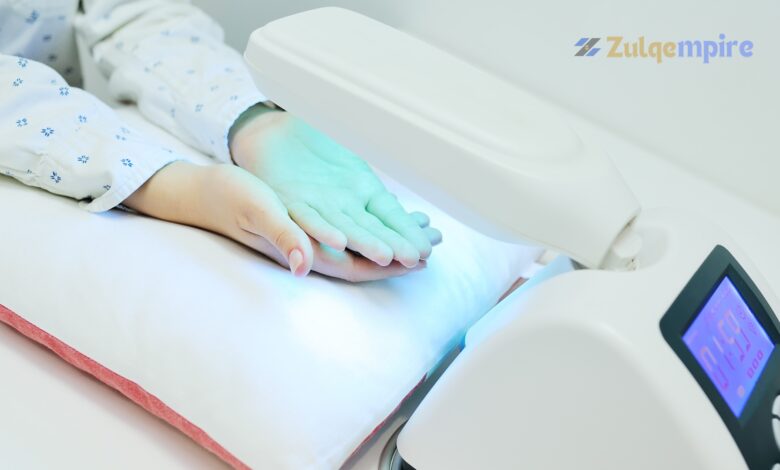Innovative Bioelectronic Patch Uses Live Bacteria for Psoriasis

Innovative Bioelectronic Patch: As a chronic autoimmune disorder, psoriasis causes skin cells to rapidly overproliferate, resulting in thick, red, and scaly patches affecting millions worldwide. A bioelectronic patch that uses living bacteria to treat psoriasis in mice has developed, which is a radical new approach compared to current treatments that try to regulate symptoms and reduce inflammation.
Researchers at the University of Chicago have come up with some groundbreaking new ideas that could revolutionize bioelectronic medicine in the future. By combining the effects of electrical stimulation with those of live organisms, this patch can revolutionize how psoriasis is managed.
Understanding Psoriasis: Skin Ecosystem Imbalance
An immune system defect is the root cause of psoriasis. The natural cell turnover process occurs when new skin cells replace older ones. People who have psoriasis have this process reversed. The overactivity of T cells, an immune cell type, causes inflammation and excessive skin cell proliferation.

Scientists are still trying to pin down what’s causing this imbalance. Still, they think it has something to do with the skin’s natural microbiome, which is a population of bacteria and other microbes that live on our bodies. A sound skin barrier and inflammation prevention are both aided by these bacteria.
The Microbiome-Inspired Bioelectronic Patch
The researchers from the University of Chicago created a bioelectronic patch to fix this problem of disrupted skin flora. The patch has two main parts:
The patch’s foundation is this pliable, supple substance which sticks gently to the skin. This particular bacterial strain is present in healthy skin and helps control inflammation. Bacteria can flourish because they are encased in a biocompatible substance that supplies them with nutrition.
An Approach Using Bacteria and Electrical Stimulation

The patch works through a two-pronged approach:
Bacterial action: S. epidermidis bacteria produce a specific metabolite that disrupts the overactive growth of skin cells. This metabolite helps to normalize the skin cell turnover rate, potentially reducing the formation of thick, psoriatic plaques.
Electrical stimulation: The patch incorporates tiny electrodes that deliver low-level electrical currents to the affected area. This gentle stimulation is believed to enhance the anti-inflammatory effects further and promote skin healing.
Mice Show Promise: A Pioneering Step
Researchers put the bioelectronic patch through its paces on psoriasis-inducing mice. The findings were promising. Compared to the control group, mice given the patch showed a marked decrease in psoriatic lesions. According to these results, the patch may help alleviate psoriasis symptoms.
Advantages and Future Directions: A Brighter Future for Psoriasis Treatment

In comparison to more conventional methods of treating psoriasis, this Innovative Bioelectronic Patch may provide some benefits:
Targeted delivery: The patch directly delivers beneficial bacteria and electrical stimulation to the affected area, minimizing systemic side effects.
Non-invasive and painless: Wearing and applying the patch should not cause discomfort.
Long-term benefits: The live bacteria in the patch could offer sustained benefits by continuously promoting a healthy skin microbiome.
Although the research is in its early phases, it signifies a notable advancement. More research should determine the patch’s safety and effectiveness in humans. Optimizing the patch’s design, distribution technique, and therapy duration are further areas requiring researchers’ attention.
More than Psoriasis: Skin Conditions Could Benefit
If this Innovative Bioelectronic Patch works as advertised, it will pave the way for further investigation into using comparable methods to treat other skin disorders. Electrical stimulation and focused alteration of the skin’s microbiota may potentially aid in treating diseases such as acne, eczema, and atopic dermatitis.
Future of Bioelectronic Medicine: New Treatment Era
The promising future of bioelectronic medicine is brought to light by this study of the psoriasis bioelectronic patch. This area can potentially create new issues by integrating biocompatible materials, live organisms, and electrical stimulation.
Additional research and development are necessary for the Innovative Bioelectronic Patch’s broad application for psoriasis and comparable skin disorders. But there is reason to be optimistic about the future; this study’s inventiveness establishes the groundwork for bioelectronic medicine to be an integral part of illness management and treatment in the years to come.
Also Read: Beyond Paxlovid: In Search of New COVID-19 Treatments




